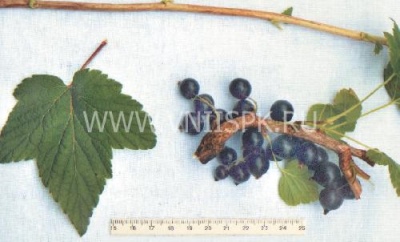
- Authors: E. V. Volodina, S. P. Khotimskaya, O. A. Tikhonova, T. V. Arsenyeva (All-Russian Research Institute of Plant Industry named after N. I. Vavilov)
- Appeared when crossing: Ojebin x Dressy
- Name synonyms: Memory of Pavlova
- Year of approval: 1991
- Ripening terms: average ripening
- Growth type: tall
- Yield: high
- Appointment: universal
- Berry weight, g: 1,2-1,5
- Tasting assessment: 4.4 points
Black currant is one of the favorite berry crops. It makes excellent jams, preserves, juices and compotes. The berry is especially rich in vitamin C. The large-fruited Binar variety is able to please with a rich harvest, unpretentious care and withstand severe frosts.
Description of the variety
The plant is tall and slightly spreading, with an average amount of foliage. Young shoots grow of medium thickness, with pubescence. Their color is green or pinkish-crimson. Lignified branches are thick and powerful, mostly straight, but can also be slightly curved, pubescent, brown in color.
The leaves are five-lobed, medium-sized, matte, dense and wrinkled, green in color. The emerging flowers are large, goblet-shaped, light pink in color, with an uneven pink tone. Fruit brushes are formed either short or medium in size, in the lower part they are longer. The length of the fruit cluster is from 4.8 to 7 cm.
Among the advantages of the variety are:
high frost resistance;
stable productivity;
large-fruited;
excellent commodity performance;
good portability;
excellent taste and aroma;
resistance to most diseases.
There are few disadvantages. This is mainly shedding of overripe berries and a pronounced sour taste.
Characteristics of berries
Binar bears fruit in large fruits. The skin is dense and shiny black. The average weight of one berry reaches 1.2-1.5 g. The shape of the fruit is round and even, with an average number of seeds of 32 pcs.
Taste qualities
The taste is sweet and sour with a predominance of acid and strong aroma. The pulp is very juicy. On a five-point tasting scale, berries are rated at 4.4 points. The number of berries on a fruit cluster is from 4 to 7 pcs. Ripe fruits are easily removed and do not flow.
Black currant fruits are rich in useful trace elements and vitamins. In particular, the content of soluble solids is 19.8%, sugars - 10.4%, titratable acid - 3.3%, ascorbic acid - 143.4 mg / 100 g, P-active substances - 375.1 mg / 100 g. , pectin - 1.0%. It is useful to use foliage, it also contains P-active substances - 2965.3 mg / 100 g. They can be dried and added to tea.
Ripening and fruiting
Refers to varieties with an average ripening period. Ripe fruits begin to be harvested closer to August. The plant is fast-growing. Fruiting occurs in the second year of planting.

Yield
The culture is high-yielding. From one bush get from 2 to 3.6 kg of berries.
Growing regions
The variety is zoned for cultivation in the North-West, North and Far East regions of Russia.
Self-fertility and the need for pollinators
Blackcurrant Binar is a self-fertile variety. The coefficient is declared at the level of 49.7%. The bush does not require pollinating neighbors. But to increase yields, it will be useful to plant several plants.
Landing
The culture is planted at rest, either in early spring before the start of sap flow, or in the middle of autumn with its completion. If this condition is met, the seedlings will take root better and will be less susceptible to disease. When choosing a location, give preference to sunny, open areas, with a slight rise, but protected from the winds. You can land near buildings and a fence, but 1.5 m from them.
For planting, choose 1- or 2-year-old specimens with a good root system, without signs of disease. The day before transplanting, the seedlings are soaked in a root-forming solution. Planting scheme - between bushes 1-1.5 m, between rows 1.5-2 m. The planting pit is prepared in advance.
The volume of the hole depends on the roots. Better to dig a bigger hole. Drainage is laid at the bottom, then there is a layer of humus with mixed wood ash, at the end it is sprinkled with garden soil. A seedling is installed in the middle of the pit, carefully sprinkled with soil and rammed. Water and mulch abundantly with sawdust or straw.

Growing and care
Competent agricultural technology in growing crops is timely irrigation and feeding. The plant spends a lot of energy on growth and fruiting. Therefore, whatever the fertile land, the soil must be enriched with nutrients.
After planting seedlings, they are watered once a week, after rooting, watering is reduced to several times a month. The bushes are irrigated as the soil dries up, but if the weather is hot and dry, you need to water more often.
Fertilization begins in the second year of development. Binar currant responds positively to both mineral and organic fertilizers. The variety is fed 3 times per season: in the spring, as the buds begin to swell, after the end of flowering and during the formation of the berries.
Pruning is carried out both in autumn and spring. Branches that bore fruit, dried, broken, diseased and frozen are subject to mandatory removal. For better wintering, a layer of mulch is laid under the seedlings to protect the roots from freezing.





Currant is one of the most favorite crops of gardeners, it can be found on almost any personal plot.In order for the currant berries to be tasty and large, and the bush itself to be healthy and strong, you should properly care for, treat and protect the plant from harmful insects. It is important to recognize the signs of the disease in a timely manner and begin treatment in the early stages of plant damage.










































































